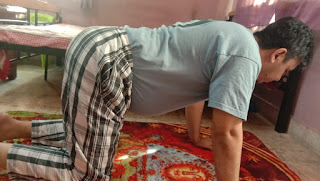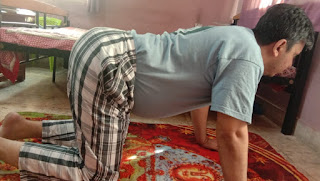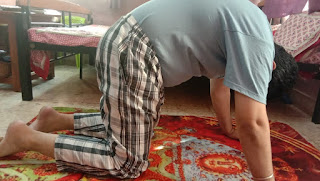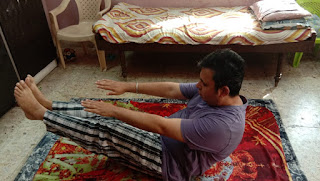Cat Pose or Marjariasana – Its Benefits and How to do it
Cat Pose or Marjariasana – Its Benefits and How to do it
Marjari means cat. Asana means Pose. So, this pose is called
as Cat Pose.
 |
| Cat Pose or Marjariasana Step 1 |
 |
| Cat Pose or Marjariasana step 2 |
 |
| Cat Pose or Marjariasana step 3 |
 |
| Cat Pose or Marjariasana step 4 |
How to do Cat Pose or Marjariasana
·
Put your knees, feet and hands on the ground.
Form a table. Back should form a table top like position. Hands and feet form
the legs of table.
·
Keep arms perpendicular to floor. Hands should
be directly under the shoulders and flat on the ground. Keep knees hip width
apart.
·
Look straight. Raise you chin and tilt your head
upwards. Push your back downwards.
·
Hold this pose for 6-8 seconds. Take long deep
breaths.
·
While exhaling arch back up as much as possible.
Drop your chin to your chest.
·
Hold this pose for 6-8 seconds.
·
Return to initial table like position.
·
This completes one round of Cat Pose or
Marjariasana.
·
Do 5-6 rounds of Cat Pose daily.
Benefits of Cat Pose or Marjariasana
·
Regular practice of Cat Pose brings flexibility
to spine. It stretches, strengthens spine and neck.
·
Wrists and shoulders become strong by practice
of this asana.
·
It massages digestive organs, improves digestion
and tones adomen.
·
It relaxes the mind, reduces anxiety.
·
It improves blood circulation.
·
It improves posture and balance.
·
It creates emotional balance.
·
It massages and stimulates organs in the belly
like kidneys and adrenal glands.
Contraindication of Cat Pose or Marjariasana
If you have back or neck related problems, consult your
doctor before doing this pose. Practice Cat Pose or Marjariasana under
supervision of a yoga teacher.
Also Read: Camel Pose



Comments
Post a Comment